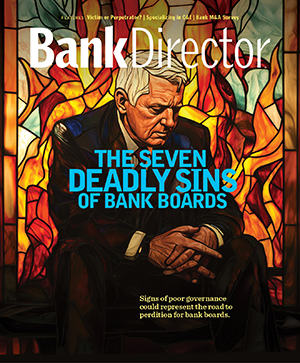Brian Leibfried is partner, managing director, and head of bank insights at Performance Trust Capital Partners, LLC, a role where he blends his extensive experience in banking and board leadership. A sought-after speaker in banking circles, Mr. Leibfried shares his insights with clarity and conviction. He brings a diverse skill set to the table, merging treasury, bank management, investment banking, and capital markets expertise. Mr. Leibfried’s approach, rooted in the shape management methodology, offers comprehensive strategies.

Banking: an Industry (Partially) at Risk
To prepare and protect the institution, banks should consider a range of possible future interest rate scenarios.
Brought to you by Performance Trust Capital Partners, LLC

*This article was published in Bank Director magazine’s fourth quarter 2024 issue.
Credit risk is omnipresent in banking, but it’s exceptionally hard to predict the magnitude or the timing of when the existence of credit risk manifests into increased provisioning.
Interest rate risk, on the other hand, is much more objective, assuming there is visibility into the asset and liability instruments on a balance sheet. Fortunately, call reports provide reasonable visibility and asset/liability management, or ALM, interest rate risk reporting provides an instrument-level assessment for every bank board and its regulator. However, inherently flawed mechanics within interest rate risk forecasting have created problems in the past two years. We call it the “beta trap” — ALM models’ inability to account for undigested prior rate moves — and it has victimized almost every bank in the country over the past 18 months. This flaw in traditional interest rate risk modeling design could camouflage this threat from the view of bank boards and regulators alike.
We are concerned many boards lack clarity around their institution’s risk or have decided to ignore it because of a faith that interest rates will fall materially in 2025 and alleviate their pain. Directors and executives should be aware of how their institution will perform if rates fall dramatically or unexpectedly move higher.
Today, we are seeing a meaningful bifurcation among institutions, based on second quarter 2024 call report data of approximately 3,600 banks with more than $125 million in assets. Approximately 2,400 of these banks appear to be stabilizing and could be poised to do well if rates remain in the 4% to 5% range, or go higher. While still potentially exposed to credit risk, these banks seem OK with respect to interest rates.
The remaining 1,200 institutions are at risk. Our analysis indicates these banks have already experienced material drawdowns in profitability since the fourth quarter of 2022 and appear to be facing continued earnings strain in coming quarters without substantial near-term cuts to the federal funds interest rate target — in the 200 basis point range. Such a move would relieve most of these banks of this current risk but is in no way guaranteed.
A Deeper Look at What’s Going On
This is a story of flawed reporting, cost of funds, or COF, changes, asset duration and available excess capital. In the second quarter of this year, the average COF of the stabilizing group was 2.1% while the at-risk group was 2.24%. The distinctive difference between stabilizing and at-risk banks lies mostly in their asset structures, which sit much farther apart. For at-risk banks, it was 4.64%; in the stable group, it was 5.32%.
The stabilizing banks have been able to keep up with changes in their institutions’ COF through loan growth and shorter asset repricing. While profitability peaked in the third and fourth quarters of 2022, the stabilizing cohort has experienced a decline of only 18 basis points in pre-tax, pre-provision (PTPP) return on average assets, generating a median of 1.54% in the second quarter of 2024. The at-risk group, in contrast, has seen their PTPP average return on assets drop by over 40 basis points, to a median of 0.63% over that same time.
Even more curiously, within the at-risk group, nearly half of the banks have leverage ratios under 9%, giving them minimal flexibility when it comes to capital. This significantly reduces the number, and size, of strategic actions they can take to improve earnings.
What To Do
Executives and boards should identify the category their institution falls in: stabilizing or at risk. If stabilizing, they should buttress their bank’s performance and begin looking for opportunities, possibly through M&A, to assist peers that aren’t as well positioned in quarters to come.
If an institution is at risk, recognize and act to remediate the situation while it’s possible. Depending on capital levels, there may be different strategies available to fortify returns, especially given the peculiar realities of the current inverted yield curve.
Until your institution knows where it resides with clarity, across a range of possible future interest rate scenarios, how can you even begin to prepare or protect it?
Performance Trust has been advising community banks for 30 years and is a registered broker/dealer, member of FINRA/SIPC. This is intended for educational and informational purposes only and is not intended to be legal, tax, financial, or accounting advice or a recommended course of action in any given situation. This is not an offer or solicitation to purchase or sell securities. The information is subject to change without notice.


